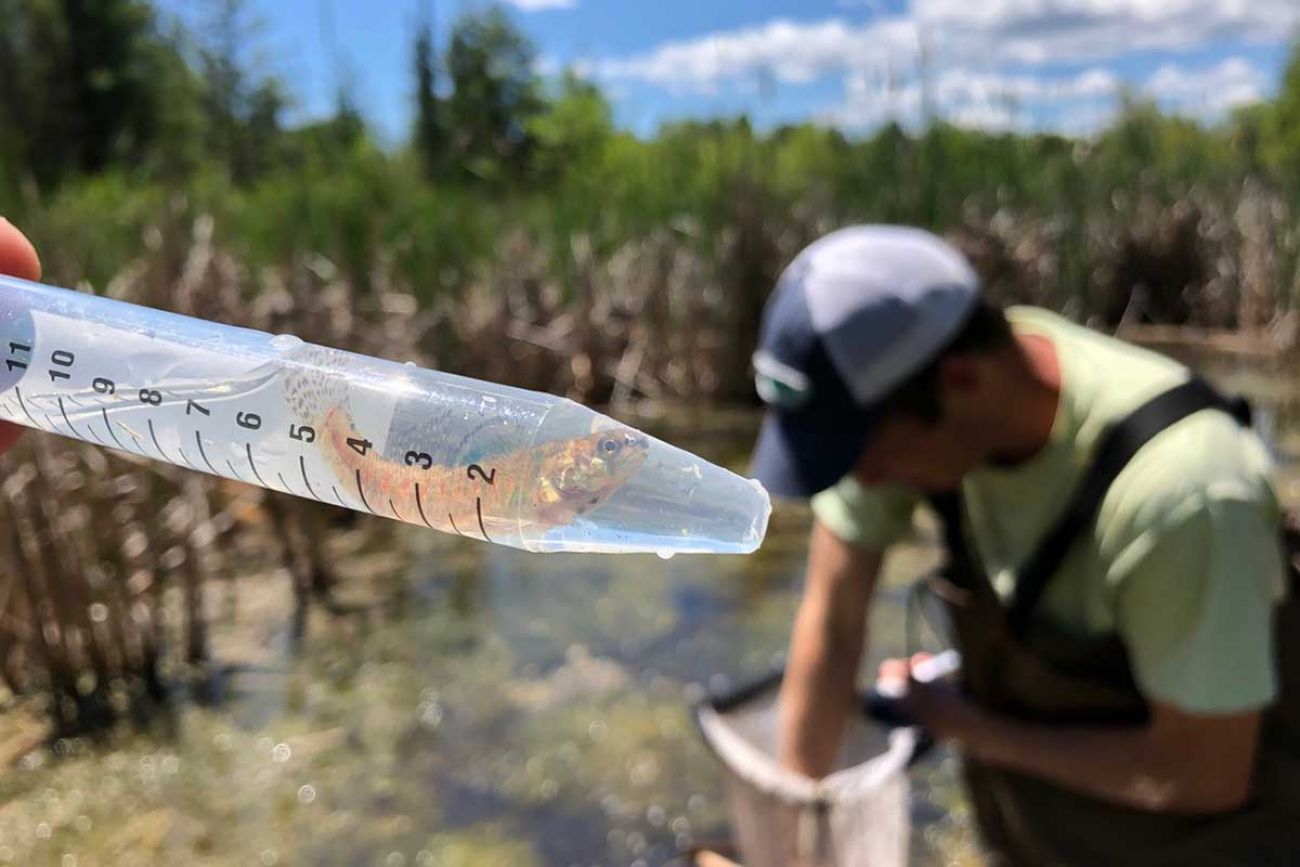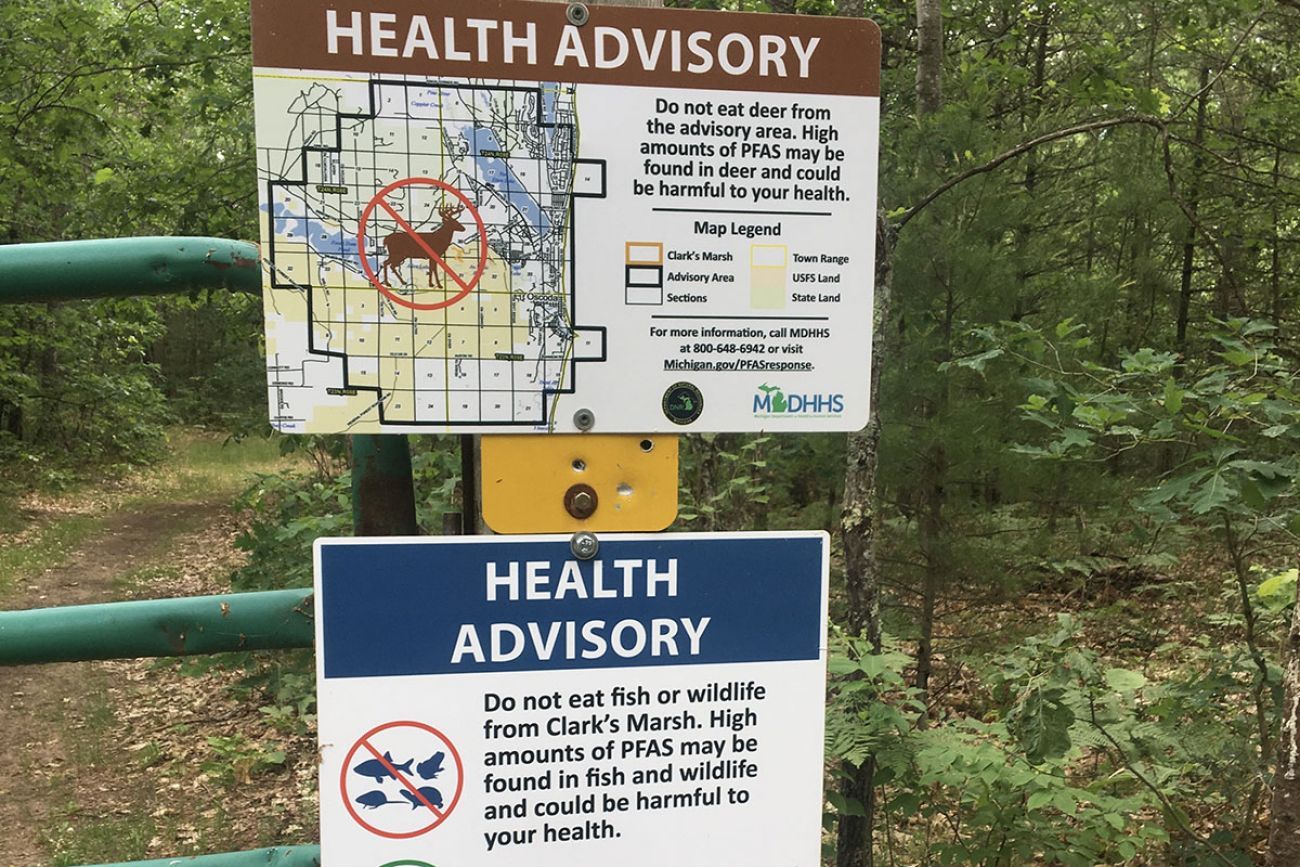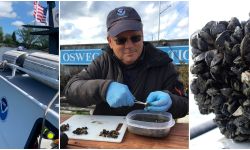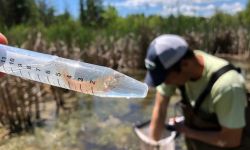Amid human health fears over PFAS, Michigan weighs new fish guidance

- State regulators are reconsidering the science behind 'do not eat' advisories for PFAS in fish
- Stronger guidance could mean more Michigan fish flagged with health warnings
- The growing toll of industrial pollution threatens an $2.3 billionfishing economy and a way of life
Fish in dozens of Michigan water bodies are under some level of a PFAS contamination advisory, and the number could be poised to grow as state officials reconsider how much tainted fish a person can safely eat.
As evidence mounts about the health risks from the so-called “forever chemicals,” the Michigan Department of Health and Human Services (MDHHS) is reviewing the science behind its PFAS “do not fish” advisories. Health officials aim to decide whether the advisories, crafted in 2014, are strong enough to protect Michiganders from illness caused by “forever chemicals” lurking in their Friday night fish fries.
“It’s an emerging contaminant, so the science is evolving monthly, daily in some cases,” said Brandon Reid, a toxicologist with MDHHS.
Related:
- EPA seeks lower PFAS drinking water standard: What it means for Michigan
- Michigan plastics company forced to probe PFAS contamination, cover costs
- Michigan Democrats aim to tighten environment regs, reduce industry control
The review comes amid pressure from environmental groups, who say they fear Michigan’s guidelines rely on outdated science that doesn’t adequately convey how toxic the chemicals are.
A widely-used class of chemicals found in everything from nonstick pans to fast food wrappers, PFAS exposure has been linked to thyroid problems, developmental issues, hormone and immunity challenges, fertility issues and cancer.
New research frequently yields bad news: The U.S. EPA, for instance, last year determined that it’s unsafe for drinking water to contain virtually any amount of two of the most ubiquitous PFAS compounds, PFOA and PFOS.
Reid said that finding will be part of the state’s review.
Research on birds indicates that drinking PFAS-tainted water is more toxic than ingesting tainted food, said Cheryl Murphy, director of the Michigan State University Center for PFAS Research. But more study is needed into the risks humans face from food.
“Most of us that don't live near a contaminated site, we're gonna get all of our contamination, mostly through our food,” Murphy said.
When present in food, the compounds enter the intestines before making their way to the liver, kidneys and bloodstream. Fish are among the most common sources of PFAS food contamination, because they can spend their lives submerged in polluted water.
The European Union — frequently out front of the U.S. in regulating chemical threats — in December released new regulations setting the “safe” level of PFAS exposure from fish at 2 parts per billion.
It takes far more PFAS to trigger a fishing advisory in Michigan.
Michigan’s current guidelines, which are warnings to anglers as opposed to enforceable regulations, focus on just one of thousands of PFAS compounds, known as PFOS. Advisories begin when the level in a fish filet exceeds 9 parts per billion (at which point adults are warned to eat no more than 16 servings a month), and grow more restrictive as PFAS levels rise. Officials issue an all-out “do not eat” advisory when PFAS levels hit 300 parts per billion.
Some environmental groups and residents of PFAS-contaminated communities want the state to ratchet down acceptable levels of exposure, and consider extending the guidelines to cover other compounds, said Erica Bloom, toxics campaign director for the Ann Arbor-based Ecology Center.
Rather than considering the risk of eating tainted fish in isolation, Bloom argued, Michigan should account for the fact that fishing is just one of many ways Michiganders are exposed to PFAS. The chemicals are also in many people’s drinking water, in fast food wrappers and common household products.
But more importantly, she said, state and federal regulators need to stop industries from discharging PFAS into waterways. Those discharges have left some Michigan communities to filter their drinking water to strip away high levels of PFAS, to meet drinking water standards that limit levels of seven compounds.
“What we believe is really needed is just turn off the tap on these chemicals,” Bloom said.
Reid said it’s too early in the state’s review to say whether Michigan will change its fish safety guidelines for PFAS. But “I do not imagine that we’ll determine that they’re too protective.”
Fishing Woes
More aggressive PFAS warnings would add to a host of worries for Bruce Yinger, a longtime recreational perch and walleye fisherman from Wyandotte.
Yinger already contends with algae blooms caused by industrial agriculture, invasive species brought in by the shipping industry, and a chemical soup of industrial pollution.
Beyond the relatively new threat of PFAS, anglers have long navigated advisories tied to mercury, PCBs and dioxins left behind by industry. Because the chemicals don’t readily break down in the environment, health threats remain long after offending factories close their doors or install pollution controls.
Yinger has been forced to adapt. He keeps only small, young fish, hoping to avoid chemicals that build up in fish as they grow.
“And I don’t personally even consider eating fish out of the Rouge River,” Yinger said.
The Rouge is among dozens of Michigan waterways already under some level of PFAS fishing advisory. Others cover smelt in several Great Lakes and inland lakes, crappie and perch in Oscoda’s Van Etten Lake, and all fish species in a vast swath of the Huron River.

A February study by the Ecology Center, Friends of the Rouge, Huron River Watershed Council and local anglers found PFAS in every fish collected from the Rouge and Huron. That included PFOS — the contaminant Michigan health officials target with fish advisories — as well as 13 other compounds.
Michigan bases its fish advisories on PFOS because it is far and away the most prevalent form of PFAS in fish, Reid said.
But activists say they’re concerned about the compounding risks anglers face when they eat fish that contain multiple types of PFAS, plus legacy pollutants like mercury and PCBs.
“We need to look more broadly at the class, and the number of PFAS that we are exposed to in one serving of fish,” said Bloom of the Ecology Center.
Expanding fish advisories could help keep the public safe. But it could also bring new threats to Michigan’s culture and economy: By one estimate, fishing is a $2.3 billion industry in Michigan. It’s also culturally important to many Michiganders, from tribal anglers who have enforceable treaty fishing rights, to state-regulated anglers who turn to rivers for recreation and sustenance.
Fishing participation is already waning amid declining public interest and a host of threats to the resource.
Paul Christensen has witnessed it firsthand in the Huron River, where he fly fishes recreationally and as a commercial guide. There are more fish than ever, he said, in part because contamination has made it unsafe for anglers to keep the fish they catch.
Christensen has always practiced catch-and-release fishing. But he worries what the mounting contamination toll means for the river ecosystem, and for the anglers who keep their catch despite “do not eat” advisories posted along the shore.
“It’s kind of a silent chemical,” Christensen said of PFAS. “You can’t see it, smell it, or feel it. The river looks clean.”
While Michigan considers updating its standards, scientists are striving to fill in the blanks about how PFAS moves through the food chain, and what impact contamination has on the fish themselves.
Research shows that exposure to the compounds can harm the liver and swim bladder and be toxic to fish embryos, among other health consequences. Those hazards have the potential to ripple through the ecosystem, Murphy said.
“If you lose a lot of fish species, you’re losing biodiversity,” she said. “That matters a lot for our own health.”
In Wyandotte, Yinger understands the need to keep anglers safe by warning against polluted fish. But he finds it maddening that more wasn’t done to keep industrial facilities from polluting Michigan’s waterways to begin with.
Much of the PFAS contamination in the Huron, for instance, was caused by a single chrome plating company, Tribar Manufacturing, that released PFAS without recourse until 2018. While Michigan has since crafted wastewater limits for three PFAS compounds, the federal government still does not require PFAS-using industries to filter PFAS out of their wastewater.
Yinger wonders what unregulated pollutants may be quietly entering Michigan’s rivers today, only to prompt a new wave of “do not eat” advisories in the years to come.
“How is it,” he asked, “that you're allowed to take relatively clean water from nature, locate your factory in a place because of it, and when you're done with the water, it’s unfit for the organisms and everything that lives there?”
Michigan Environment Watch
Michigan Environment Watch examines how public policy, industry, and other factors interact with the state’s trove of natural resources.
- See full coverage
- Subscribe
- Share tips and questions with Bridge environment reporter Kelly House
Michigan Environment Watch is made possible by generous financial support from:
Our generous Environment Watch underwriters encourage Bridge Michigan readers to also support civic journalism by becoming Bridge members. Please consider joining today.
See what new members are saying about why they donated to Bridge Michigan:
- “In order for this information to be accurate and unbiased it must be underwritten by its readers, not by special interests.” - Larry S.
- “Not many other media sources report on the topics Bridge does.” - Susan B.
- “Your journalism is outstanding and rare these days.” - Mark S.
If you want to ensure the future of nonpartisan, nonprofit Michigan journalism, please become a member today. You, too, will be asked why you donated and maybe we'll feature your quote next time!






